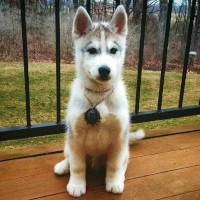Appearance of the Husky Jack
|
| Husky Jacks are unique-looking dogs. They are medium-sized and muscular, with pricked or half-pricked ears. They generally reach a height of 43 to 48 centimeters and a weight of 13.5 to 18 kilos. Husky Jacks have an arched neck and robust posture, like that of a Jack Russell Terrier. Yet they also have powerful fore and hind legs and oval padded feet, like a Siberian Husky. Their coats are generally short and smooth with a soft undercoat and come in solid or multicolored variations of white, black, gray, red, sable and agouti with black, brown, beige, cream or tricolor markings. Husky Jacks have almond-shaped brown or blue eyes and a friendly, almost awkward expression. Overall, these dogs exude energy with their agile, bouncy gait. |
Temperament of the Husky Jack
|
| Husky Jacks are high-energy puppies. They like to be active and social. This breed is friendly with most other dogs, but is known to assert dominance in groups. As such, it's best to supervise Husky Jacks around new furry friends. Fortunately, Husky Jacks also value their independence and enjoy playing alone or in the company of their favorite chew toy. These puppies are also highly intelligent and mischievous by nature. As a result, they can be stubborn and harder to train than some other breeds. Owners can combat this to some extent with obedience training and socialization from an early age. Note also that, given their bold temperament, Husky Jacks may not be the best companion for new owners, young children and cats. Yet this feisty animal can be very affectionate and loyal to family members, and will never miss an opportunity to give and receive a little love. |
Needs and activities of the Husky Jack
|
| Husky Jacks have above-average energy levels and need plenty of exercise. They love long runs, hikes and walks and should get between 45 and 90 minutes of such exercise a day. They may even enjoy a trip to the dog park. As such, Husky Jacks do best when they have access to a yard in a rural or suburban area. Yet, because they're medium-sized, Husky Jacks can acclimatize to city or apartment life if they spend enough time outdoors. Husky Jacks also love toys and can entertain themselves for long periods if they have something to chew on. Nevertheless, it's important to note that spending quality time with his family is also an important part of this puppy's day. |
Maintenance of the Husky Jack
|
| Husky Jacks are not hypoallergenic dogs and are therefore not suitable for owners suffering from allergies. Their smooth, short coats don't require much grooming. However, Husky Jacks do shed a lot, especially twice a year when the seasons change. Owners can reduce shedding and keep their Husky Jacks' coats clean and shiny with weekly brushing sessions. This breed should also be bathed monthly and have its ears checked regularly for wax build-up. In addition, Husky Jacks should have their nails trimmed 1-2 times a month to prevent painful proliferation or nail separation. Like all breeds, Husky Jacks should have their teeth brushed daily. |









 English (United Kingdom)
English (United Kingdom)